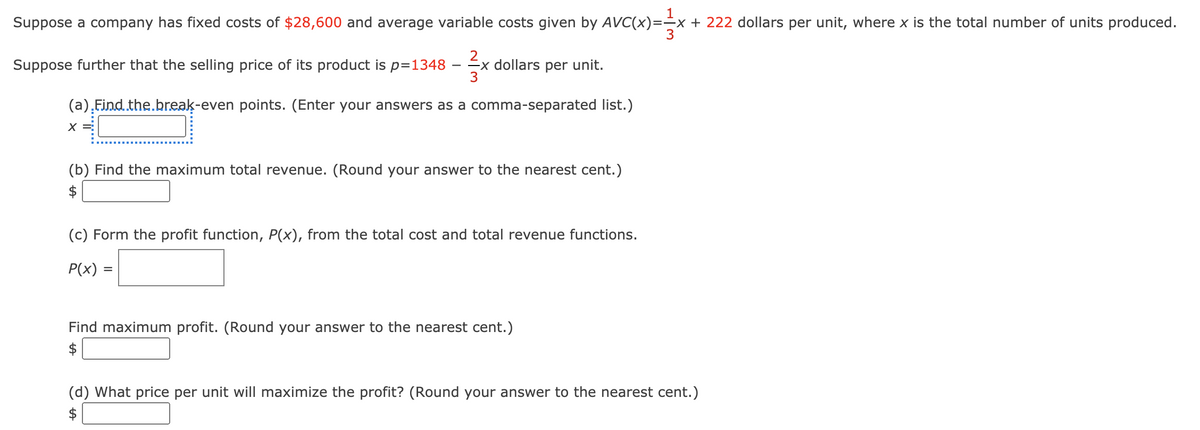Suppose a company has fixed costs of $28,600 and average variable costs given by AVC(x)==x + 222 dollars per unit, where x is the total number of units produced. Suppose further that the selling price of its product is p=1348 – x - dollars per unit. (a), Eind.the.break-even points. (Enter your answers as a comma-separated list.) (b) Find the maximum total revenue. (Round your answer to the nearest cent.) $ (c) Form the profit function, P(x), from the total cost and total revenue functions. P(x) = Find maximum profit. (Round your answer to the nearest cent.) $ (d) What price per unit will maximize the profit? (Round your answer to the nearest cent.) $
Suppose a company has fixed costs of $28,600 and average variable costs given by AVC(x)==x + 222 dollars per unit, where x is the total number of units produced. Suppose further that the selling price of its product is p=1348 – x - dollars per unit. (a), Eind.the.break-even points. (Enter your answers as a comma-separated list.) (b) Find the maximum total revenue. (Round your answer to the nearest cent.) $ (c) Form the profit function, P(x), from the total cost and total revenue functions. P(x) = Find maximum profit. (Round your answer to the nearest cent.) $ (d) What price per unit will maximize the profit? (Round your answer to the nearest cent.) $
Managerial Economics: Applications, Strategies and Tactics (MindTap Course List)
14th Edition
ISBN:9781305506381
Author:James R. McGuigan, R. Charles Moyer, Frederick H.deB. Harris
Publisher:James R. McGuigan, R. Charles Moyer, Frederick H.deB. Harris
Chapter9: Applications Of Cost Theory
Section: Chapter Questions
Problem 3E
Related questions
Question

Transcribed Image Text:Suppose a company has fixed costs of $28,600 and average variable costs given by AVC(x)=
1
+ 222 dollars per unit, where x is the total number of units produced.
Suppose further that the selling price of its product is p=1348
Ex dollars per unit.
3
(a),Eind.the.break-even points. (Enter your answers as a comma-separated list.)
(b) Find the maximum total revenue. (Round your answer to the nearest cent.)
$
(c) Form the profit function, P(x), from the total cost and total revenue functions.
P(x) =
Find maximum profit. (Round your answer to the nearest cent.)
$
(d) What price per unit will maximize the profit? (Round your answer to the nearest cent.)
$
Expert Solution
This question has been solved!
Explore an expertly crafted, step-by-step solution for a thorough understanding of key concepts.
This is a popular solution!
Trending now
This is a popular solution!
Step by step
Solved in 3 steps with 4 images

Knowledge Booster
Learn more about
Need a deep-dive on the concept behind this application? Look no further. Learn more about this topic, economics and related others by exploring similar questions and additional content below.Recommended textbooks for you

Managerial Economics: Applications, Strategies an…
Economics
ISBN:
9781305506381
Author:
James R. McGuigan, R. Charles Moyer, Frederick H.deB. Harris
Publisher:
Cengage Learning

Managerial Economics: A Problem Solving Approach
Economics
ISBN:
9781337106665
Author:
Luke M. Froeb, Brian T. McCann, Michael R. Ward, Mike Shor
Publisher:
Cengage Learning


Managerial Economics: Applications, Strategies an…
Economics
ISBN:
9781305506381
Author:
James R. McGuigan, R. Charles Moyer, Frederick H.deB. Harris
Publisher:
Cengage Learning

Managerial Economics: A Problem Solving Approach
Economics
ISBN:
9781337106665
Author:
Luke M. Froeb, Brian T. McCann, Michael R. Ward, Mike Shor
Publisher:
Cengage Learning


Economics: Private and Public Choice (MindTap Cou…
Economics
ISBN:
9781305506725
Author:
James D. Gwartney, Richard L. Stroup, Russell S. Sobel, David A. Macpherson
Publisher:
Cengage Learning

Microeconomics: Private and Public Choice (MindTa…
Economics
ISBN:
9781305506893
Author:
James D. Gwartney, Richard L. Stroup, Russell S. Sobel, David A. Macpherson
Publisher:
Cengage Learning
